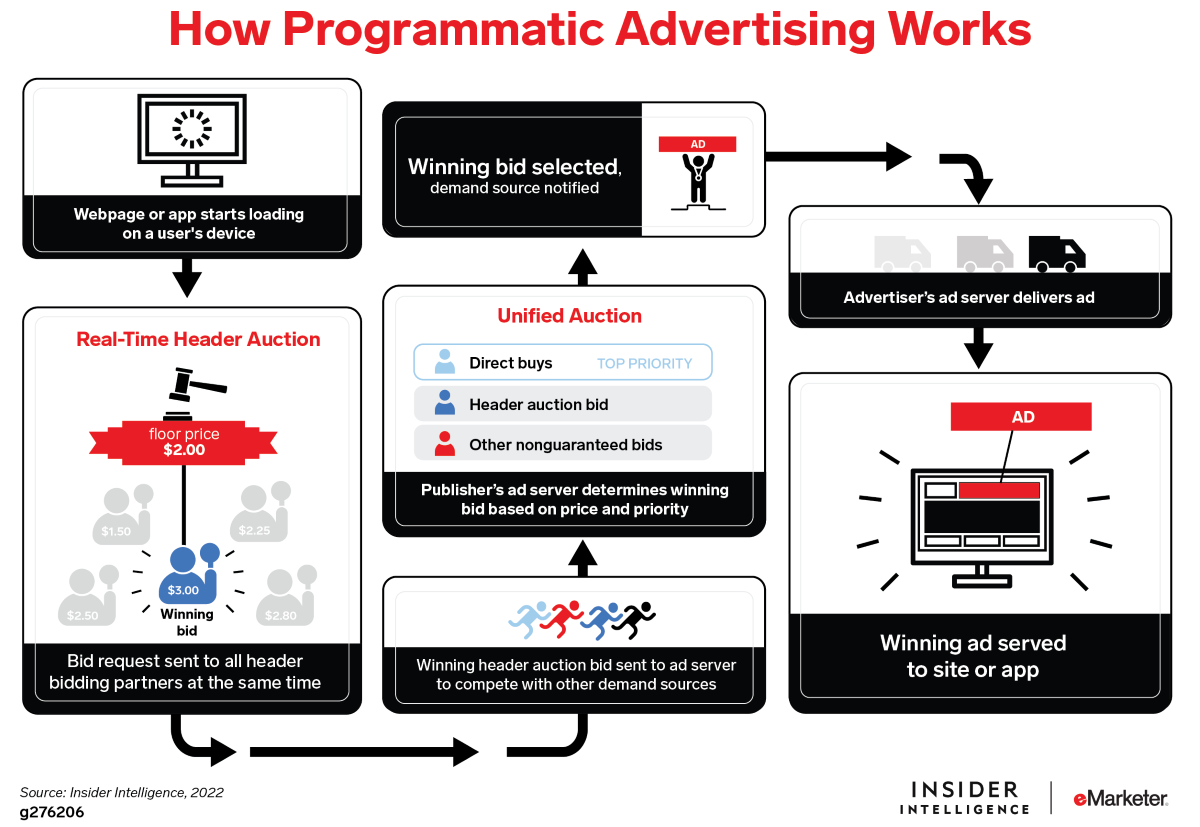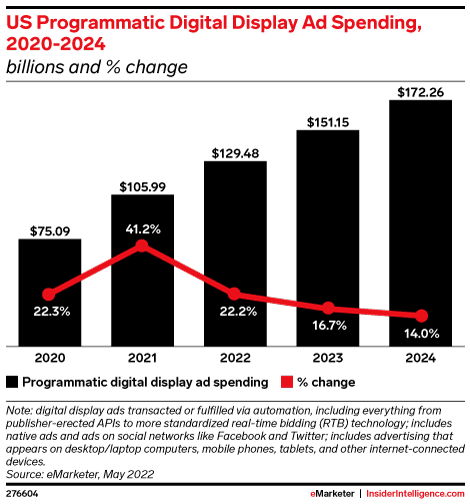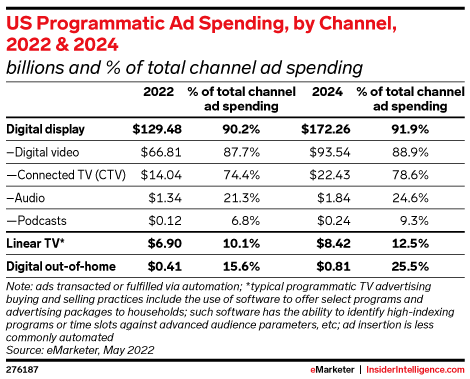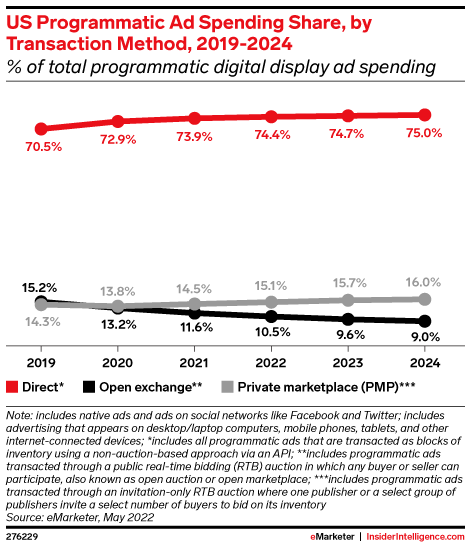ANA Releases Programmatic Buying Guide: Top Takeaways and Tinuiti POV


The Association of National Advertisers (ANA) recently released a data and insights-packed guide that lays bare all things programmatic advertising. The CMO’s Guide to Programmatic Transparency was designed to help CMOs maximize their programmatic ROI, and is a collaborative effort of 30+ top digital marketing experts and partners worldwide.
In this article, we explore:
Programmatic advertising is online advertising that is bought and sold via an automated technology platform, or ad exchange. Programmatic refers to the buying and selling method itself, not the advertising unit or where it will be served to the potential customer.

Programmatic media buying is designed to increase efficiency and scale, algorithmically ‘making decisions’ about when to buy or sell and serve an ad impression—and to/from whom, at what price—based on a variety of factors and available data.
It’s important to note that programmatic is neither trendy nor new: its use has been steadily climbing for the last decade. In our experience, many business leaders don’t realize that much of their current advertising is being purchased programmatically, particularly Display.
While not synonymous with or exclusive to Display advertising, there is good reason people have strong associations between Programmatic and Display; according to a recent report from eMarketer, “over 90% of digital display advertising transacts programmatically,” and that already-huge percentage is only climbing.

But Display is not alone. In addition to increases in programmatic display spend, eMarketer’s report also shows predicted growth across programmatically purchased digital video ads, connected TV (CTV) ads, audio ads, podcast ads, linear TV ads, and digital out-of-home (DOOH) advertising.


Perhaps the most popular and common type of programmatic advertising involves real-time bidding environments, but there are other types to consider as well:
Now that we’ve explored how expansive programmatic advertising is across a variety of channels, let’s take a high-level look at the ANA’s recent guide.
The ANA, or Association of National Advertisers, was founded in 1910, and is the largest and longest-established trade association in the US advertising industry. Formerly known as the “Association of National Advertising Managers, it was established to promote cooperative relationships between regional and national advertising industries, manufacturers and dealers, and advertisers and agencies.”
The ANA’s guide is designed to serve as a comprehensive, step-by-step resource that helps chief marketing officers make the most effective, informed, efficient decisions within their full programmatic advertising process.
Some sections within the guide include:
The goal is that improved efficiency will reduce costs on the operational side of programmatic advertising, freeing up more budget for media spend itself. This would effectively help businesses reach more customers for the same cost, fueling increased economic growth.
From The CMO’s Guide to Programmatic Transparency:
“Our goal is to help CMOs recover 10 cents on every dollar they spend on digital marketing to drive $10 billion in reinvested saving in the digital marketing ecosystem. This goal is obtainable with the participation of just 500 CMOs. We hope you will be one of them.”
In addition to its clear purpose, the guide has an equally clear intended effect. The ANA states that by following the advice offered in the guide—effectively streamlining the entire programmatic marketing process—“the industry as a whole would be able to generate US$10 billion to turn back into working media investment.”
So how do Tinuiti’s programmatic processes stack up against the ANA’s recommendations? And are all of the many steps outlined in their guide truly necessary if you’re working with the right partners?
We sat down with Geoff Litwer, VP of Programmatic and Display Media at Tinuiti and Kolin Kleveno, SVP of Addressable Audiences at Tinuiti, to learn more.

A: It all starts with the way we write our contract language with clients. How can we be a true partner to our clients if we are not empowering them to own their campaigns, data and audiences—to have full visibility into the supply-path and associated fees?
When we set-up campaigns in platforms, we do it in a way that makes it easiest for the client to
own that campaign—to own the data, and be able to transfer the campaign, if needed, in the future. Agencies should not hold campaigns hostage.
The guide makes some great points, and offers insightful questions to ask, but if you trust that your agency is doing their due diligence and leveraging best practices, you don’t have as much to worry about. Invest that time in finding an agency you trust.
If agencies are using a client’s money to benefit themselves, they are no longer an agent of that client; it’s vitally important to find a partner who meets the fundamentals of what an agent truly is.
How many parties/vendors are typically involved in a programmatic buy ‘supply chain’ for Tinuiti clients, and who are they?
A: There is always a publisher, advertiser, SSP (supply-side platform), agency and DSP (demand-side platform) invited to the party. It grows from there, but just to give an idea that at the bare bones foundation, we’re already looking at 5 players.
But it is important to remember why we implemented programmatic technology in the first place. Working directly with each publisher was inefficient and not scalable. Programmatic solved for this, and has really accelerated the shift of investment from traditional to digital.
A: Managed service buying models and data. Managed service refers to a more white-glove-like solution that agencies and brands use to fully outsource the management of media buys for a non-disclosed fee, typically baked into a flat CPM. Bidding in an auction environment, these providers generate significant profits by leveraging auction dynamics to arbitrage.
A: We are 100% transparent, and help our clients avoid the “ad-tech tax” by eliminating unnecessary middlemen, data hops, and auction gaming via our unique approach. One big piece of this is our Tinuiti Curated Marketplaces, which have enabled our clients to shift spend out of the open exchange where—when unchecked—can be rife with fraud and inefficiencies, and tap into viewable, brand-safe, premium inventory without sacrificing scale or efficiency.
We are able to do this through our unique SSP and Publisher partnerships, as well as our ability to apply AI and machine learning to the vast amounts of bidstream data that we see, to empower our clients to make smarter decisions in real time.
Rather than constantly trying to weed out the junk in real time, we’ve pre-filtered everything, including: curated publishers; sections within publisher sites we want to show; ad units within those publishers that perform well; certain audiences that are built into that inventory from those publishers—so very high-quality data and inventory. And we’re doing it in a way so that brands can still find the efficiency of programmatic in a more elevated, quality, safe environment. This is a new initiative that we are very excited about!
A: We work very closely with only a few supply partners that are able to provide us with the level of transparency in contracting and pricing, as well as the granularity of data passback, that we are looking for.
A:
A: We are programmatic purists in that we believe in maximum transparency across the supply-chain and having as direct-a-path as possible to technology, inventory and audiences so that the efficiency and efficacy of programmatic can actually be realized. Our proprietary intelligence platform, Mobius, powers advanced optimization and measurement of real business outcomes, not platform or proxy metrics. This framework enables our clients to deliver impactful, immersive media experiences to their most valuable audiences.
